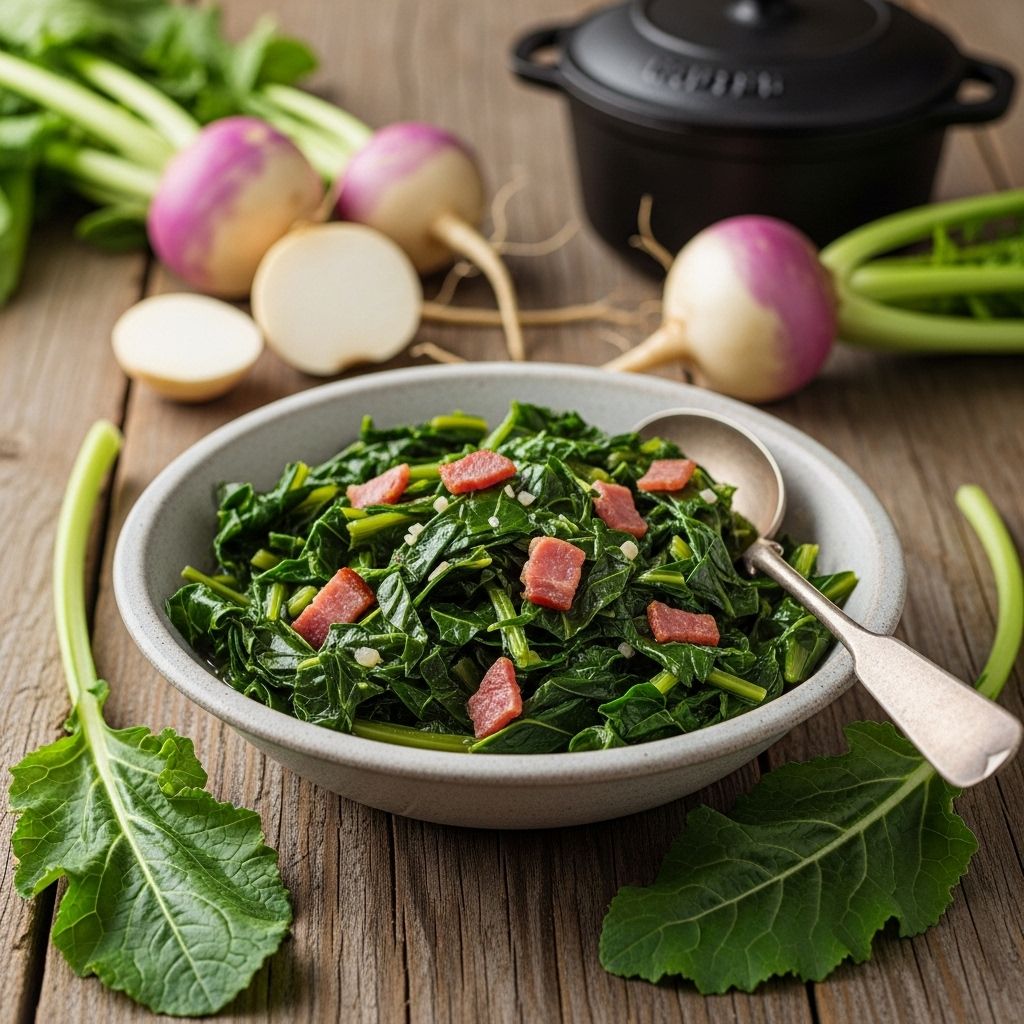Southern Turnip Greens Recipe: Authentic Flavor In 6 Easy Steps
A classic Southern side dish featuring tender turnip greens simmered with flavorful bacon and seasonings

Image: HearthJunction Design Team
Healthy and Delicious Southern Turnip Greens
Southern turnip greens hold a special place in traditional Southern cuisine. This nutritious leafy vegetable transforms into a delectable side dish when simmered with smoky bacon, aromatic onions, and a perfect blend of seasonings. The result is tender, flavorful greens with a savory pot liquor that’s perfect for sopping up with a piece of homemade cornbread. This recipe honors the time-tested Southern method of cooking greens while ensuring they retain their nutrients and vibrant flavor.
What Are Turnip Greens?
Turnip greens are the leafy tops of the turnip plant (Brassica rapa). While the turnip root is popularly used in many dishes, the greens are especially prized in Southern cooking for their earthy flavor and impressive nutritional profile. These greens are packed with vitamins A, C, and K, along with calcium and folate, making them not only delicious but extremely beneficial for your health.
In Southern cuisine, turnip greens have been a staple for generations, often cooked low and slow with pork for flavor. This method developed during times when people needed to make the most of every ingredient and has evolved into the beloved dishes we enjoy today.
Why You’ll Love This Recipe
This Southern turnip greens recipe strikes the perfect balance between traditional flavor and modern preparation. Here’s why you’ll find yourself making it again and again:
- Authentic Flavor: The combination of bacon, onions, garlic, and seasonings creates that unmistakable Southern taste.
- Balanced Seasoning: A touch of sugar and apple cider vinegar cuts through the natural bitterness of the greens.
- Versatile Side Dish: These greens pair beautifully with almost any main course, from fried chicken to pork chops.
- Nutritional Powerhouse: Enjoy a delicious side that’s also packed with essential vitamins and minerals.
- Simple Preparation: Despite their complex flavor, these greens are surprisingly easy to make.
Ingredients You’ll Need
To prepare these authentic Southern turnip greens, gather these simple ingredients:
- 1 (12 oz.) package uncooked bacon strips, diced
- 1 small onion, peeled and diced
- 3/4 teaspoon salt
- 1 teaspoon granulated sugar
- 1/4 teaspoon crushed red pepper flakes (optional, for heat)
- 3 garlic cloves, peeled and minced
- 1 (16 oz.) bag chopped raw turnip greens, rinsed and dried
- 2 teaspoons apple cider vinegar
- 3/4 cup chicken broth
Equipment Required
You’ll need just a few basic kitchen tools to prepare this dish:
- Large non-stick skillet with lid
- Sharp knife and cutting board
- Measuring spoons and cups
- Wooden spoon or heat-resistant spatula
- Paper towels
- Fork (for testing doneness)
Step-by-Step Instructions
Follow these detailed instructions to create perfectly cooked Southern turnip greens:
Step 1: Cook the Bacon
In a large non-stick skillet, add the diced bacon. Cook on medium-low heat, stirring occasionally until the bacon fat renders and the bacon is almost crisp but still meaty, about 10 minutes. This slow cooking process allows the bacon to release its flavorful fat while maintaining some texture. Once cooked, remove half of the bacon from the pan and set it aside on a paper towel-lined plate or container. You’ll use this reserved bacon as a garnish later.
Step 2: Sauté the Aromatics
To the remaining bacon and rendered fat in the pan, add the diced onion, salt, sugar, and crushed red pepper flakes (if using). The sugar helps balance the natural bitterness of the turnip greens, while the red pepper flakes add a pleasant warmth. Cook, stirring occasionally, until the onion begins to caramelize, about 2 minutes. The onions should become translucent and slightly golden at the edges.
Step 3: Add the Garlic
Stir the minced garlic into the onion mixture and cook for about 30 seconds, just until fragrant. Be careful not to burn the garlic, as it can quickly become bitter if overcooked.
Step 4: Wilt the Greens
Add half of the turnip greens to the pan, turning them in the hot oil until slightly wilted. This will create room in the pan for the remaining greens. Once the first batch has wilted somewhat, add the remaining turnip greens and continue turning them until all greens are just wilted. The volume will reduce significantly as the greens cook down.
Step 5: Add Liquids and Simmer
Pour in the apple cider vinegar and chicken stock. The vinegar adds brightness and helps tenderize the greens, while the chicken stock provides depth of flavor and moisture. Cover the skillet and simmer for 5 minutes to allow the flavors to meld and the greens to begin softening.
Step 6: Finish Cooking
Remove the cover and simmer an additional 10 to 15 minutes, or until the turnip stems are fork tender. The uncovered cooking allows some of the liquid to reduce, concentrating the flavors into a delicious pot liquor. The greens should be tender but not mushy when done.
Serving Suggestions
Southern turnip greens are traditionally served with their flavorful cooking liquid, known as pot liquor. Here are some perfect pairings for your turnip greens:
- Cornbread: A slice of hot cornbread is the perfect accompaniment, ideal for soaking up the delicious pot liquor.
- Hot Sauce: Many Southerners enjoy adding a dash of hot sauce for extra kick.
- Main Dishes: These greens complement fried chicken, pork chops, meatloaf, or country ham beautifully.
- Garnish: Top with the reserved crispy bacon pieces just before serving for added texture and flavor.
Storage and Reheating Tips
One of the benefits of turnip greens is that they often taste even better the next day, after the flavors have had time to meld. Here’s how to store and reheat any leftovers:
- Refrigeration: Store cooled turnip greens in an airtight container in the refrigerator for up to 3-4 days.
- Reheating: Gently reheat on the stovetop over medium-low heat until warmed through. You may need to add a splash of water or broth if the greens seem dry.
- Freezing: Turnip greens freeze well. Store in freezer-safe containers for up to 3 months. Thaw overnight in the refrigerator before reheating.
Variations and Substitutions
While this recipe captures the authentic Southern approach to turnip greens, you can adapt it to suit your preferences:
- Meat Options: Replace bacon with ham hocks, salt pork, or smoked turkey wings for different flavor profiles.
- Vegetarian Version: Omit the bacon and use vegetable broth instead of chicken broth. Add a teaspoon of smoked paprika for a smoky flavor.
- Greens Mixture: Create a mixed greens dish by combining turnip greens with collards, mustard greens, or kale.
- Added Vegetables: Some cooks like to add diced turnip roots or potatoes to the greens for additional texture.
- Extra Heat: For spicier greens, increase the red pepper flakes or add a diced jalapeño with the onions.
Tips for Perfect Southern Turnip Greens
Follow these professional tips to ensure your turnip greens turn out perfectly every time:
- Thorough Washing: Even pre-packaged greens benefit from an additional rinse to remove any grit.
- Don’t Rush: The slow cooking process allows the flavors to develop fully and the greens to tenderize properly.
- Balance is Key: The combination of salt, sugar, and vinegar creates the perfect flavor balance. Adjust to your taste.
- Taste Before Serving: Greens may need additional seasoning at the end of cooking.
- Pot Liquor: Don’t discard the cooking liquid—it’s full of nutrients and flavor!
Nutritional Benefits of Turnip Greens
Beyond their delicious flavor, turnip greens offer impressive nutritional benefits:
- Vitamin A: Essential for vision, immune function, and cell growth
- Vitamin C: Supports immune health and collagen production
- Vitamin K: Important for blood clotting and bone health
- Calcium: Promotes strong bones and teeth
- Folate: Critical for cell division and DNA synthesis
- Fiber: Supports digestive health and helps maintain healthy cholesterol levels
- Antioxidants: Help combat oxidative stress and inflammation
Frequently Asked Questions (FAQs)
Q: How do I remove bitterness from turnip greens?
A: The combination of sugar and apple cider vinegar in this recipe helps balance the natural bitterness of turnip greens. If you find your greens still too bitter, you can add a touch more sugar or a pinch of baking soda during cooking.
Q: Can I use frozen turnip greens instead of fresh?
A: Yes, frozen turnip greens work well in this recipe. There’s no need to thaw them first—just add them directly to the pan and adjust the cooking time as needed, usually adding a few extra minutes.
Q: How can I tell when turnip greens are properly cooked?
A: Properly cooked turnip greens should be tender but not mushy. The stems should be easily pierced with a fork. If the greens still seem tough, continue cooking and check every few minutes.
Q: Are turnip greens and collard greens the same thing?
A: No, they’re different greens, though they’re often prepared similarly. Turnip greens have a slightly more peppery flavor compared to the milder taste of collard greens. Both work well with this cooking method.
Q: What’s the purpose of the vinegar in this recipe?
A: The apple cider vinegar serves multiple purposes: it helps cut the bitterness of the greens, adds a bright note to balance the richness of the bacon, and helps tenderize the greens during cooking.
Embrace this Southern cooking tradition and enjoy the rich flavors and numerous health benefits of properly prepared turnip greens. Whether served alongside your favorite main dish or enjoyed on their own with a piece of cornbread, these greens represent Southern comfort food at its finest.
References
- https://www.allrecipes.com/recipe/239957/easy-turnip-greens/
- https://www.allrecipes.com/recipe/282940/turnip-greens-with-bacon/
- https://www.allrecipes.com/recipe/199134/southern-turnip-supreme/
- https://www.allrecipes.com/recipe/232705/turnip-green-soup/
- https://cookthestory.com/southern-turnip-greens-recipe/
Read full bio of Anjali Sayee












